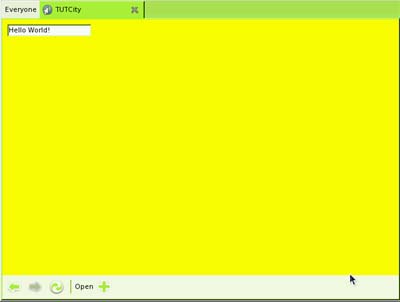OLPCities/TextArea: Difference between revisions
Jump to navigation
Jump to search
No edit summary |
No edit summary |
||
| Line 1: | Line 1: | ||
"TextArea" is a Class that is part of the DOM (Document Object Model). This "library" is referenced automaticaly by the browser of the OLPC station and you don't need to add anything in the program to use it. |
|||
SOON |
|||
You will use textareas when you have muptiple llines of text to display. You specify the number of rows and columns you want. It will have automatically scroolbars if needed. |
|||
To create an object of the Class you will use the <b>tag</b> TEXTAREA defining a TYPE=TEXT, NAME and COLS and ROWS. Eventually: VALUE. The object will be used in a chain of objects. Something like this will work : |
|||
<pre> |
|||
<html> |
|||
<head> |
|||
<form name="form1"> |
|||
<input type=text name="tb1"> |
|||
</form> |
|||
<script language="Javascript"> |
|||
function init(){ |
|||
document.form1.tb1.value ="Hello World!"; |
|||
} |
|||
</script> |
|||
</head> |
|||
<title>TUTCity</title> |
|||
<center> |
|||
<body bgcolor="yellow" onload=init()> |
|||
</center> |
|||
</html> |
|||
</pre> |
|||
[[Image: Textbox.jpg]] |
|||
==Properties== |
|||
<pre> |
|||
value [=String] Is R/w .The String inside the text box. |
|||
By example: we can capture what was typed at a textbox with: |
|||
document.form1.tb1.value (or towrite it, like in the example) |
|||
size [=n] |
|||
</pre> |
|||
Link to the Classes:[[Document]] [[Form]] |
|||
[[Category:OLPCities]] |
|||
Revision as of 11:02, 1 October 2006
"TextArea" is a Class that is part of the DOM (Document Object Model). This "library" is referenced automaticaly by the browser of the OLPC station and you don't need to add anything in the program to use it.
You will use textareas when you have muptiple llines of text to display. You specify the number of rows and columns you want. It will have automatically scroolbars if needed.
To create an object of the Class you will use the tag TEXTAREA defining a TYPE=TEXT, NAME and COLS and ROWS. Eventually: VALUE. The object will be used in a chain of objects. Something like this will work :
<html>
<head>
<form name="form1">
<input type=text name="tb1">
</form>
<script language="Javascript">
function init(){
document.form1.tb1.value ="Hello World!";
}
</script>
</head>
<title>TUTCity</title>
<center>
<body bgcolor="yellow" onload=init()>
</center>
</html>
Properties
value [=String] Is R/w .The String inside the text box.
By example: we can capture what was typed at a textbox with:
document.form1.tb1.value (or towrite it, like in the example)
size [=n]
